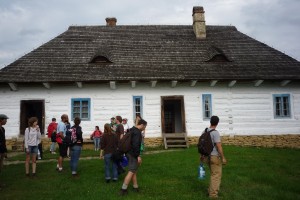
CEREV student participates in “heritage animation” project in Poland
This summer I had the great privilege of participating as a volunteer in The Gwozdziec Synagogue Reconstruction Project. This is an ongoing project to rebuild a scaled replica of a timber-framed synagogue roof structure that dates from the seventeenth century. The roof structure we built, which includes a vaulted painted ceiling and cupola, will be installed in The Museum of the History of Polish Jews, which will open in Warsaw, Poland in 2013, and will be a major contribution to its permanent exhibition.
This historical museum will be one-of-a-kind for the way it will showcase the thousand-year history of the Jewish diaspora in Poland. As a visitor, one will be able to look inside the reconstructed roof and witness a magnificent combination of wood craftsmanship and decorative painting that are part of what make this synagogue “a high point in Jewish architectural art and religious painting.”
The project was commissioned by a non-profit historic preservation organization based in Massachusetts called Handshouse Studio, whose mandate is to educate student volunteers in traditional building practices while creating original reconstructions of lost architectural heritage. At the worksite, traditional hand tools used in the craft of timber framing were made available to volunteers like me, with whom members of the Timber Framer’s Guild shared their expertise on how to properly hew timbers, layout and cut joinery, and assemble the final structure. All of this took place in the beautiful town of Sanok, located in southeastern Poland at the foot of the Carpathian mountains, in the Open-Air Ethnographic Museum, a perfect location for a building project involving forty to fifty people at once. A guided tour of the outdoor museum offered direct experience of a variety of examples of Poland’s ethnic architectural heritage, including churches and cottages, which dotted the area around where we were building.
This was truly a once-in-a-lifetime experience for the talent, creativity, and positive energy it brought together. I learned about a craft and a particular period in Polish-Jewish history in a uniquely experiential way, and through my labors many other people will experience what it must have felt like to stand inside the walls of this singular, long-lost monument. I witnessed the final stage of the building portion of the project, which has been underway since 2004; reproduction of the painted interior will be completed next year. While I was only in Sanok for one week, I will cherish the experience of meeting so many different people who brought their own original views and experiences to this truly collaborative project of re-animating history.
Click here to see a video of the project (with Ozan visible at 3:37!)
Post and photos by Ozan Golland





